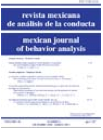The nature of a conditioned response is detennined by spatial location of tite conditioned stimulus
Main Article Content
Abstract
This study assessed tite effects of sp at ial contiguity between a keyligltt andfoodpre¬sentation Qn orientation, approach and contact responses with tite Iteylight itt an autosha¬ping procedure with pigeons. itt Experitnent 1, tite effects of progressively increasing tite distance between tite keylight and food hopper were assessed itt five pigeons. in Experi¬ment 2, tite effects of tite twa extreme values of spatial conttguity used itt Experitnent 1 were assessed att tite behavior of dx pigeons. ín batir experitnents it wasfound that con¬tact witlt tite lteylight was more likely token tite keylight was clase to tite food hopper that when it toas some distance away from it; Qn tite otiter hand, approacit responses were more likely witen tite keylight was at sorne distance from tite food hopper. Titese fin.dings are discussed itt relation to tite dist inct ion between preparatory and consuntmatory beitaviors proposed by Konorski.
Article Details
How to Cite
Cabrera, R., & Vila, J. (2011). The nature of a conditioned response is detennined by spatial location of tite conditioned stimulus. Mexican Journal of Behavior Analysis, 1(1), 19–32. https://doi.org/10.5514/rmac.v1.i1.27055
